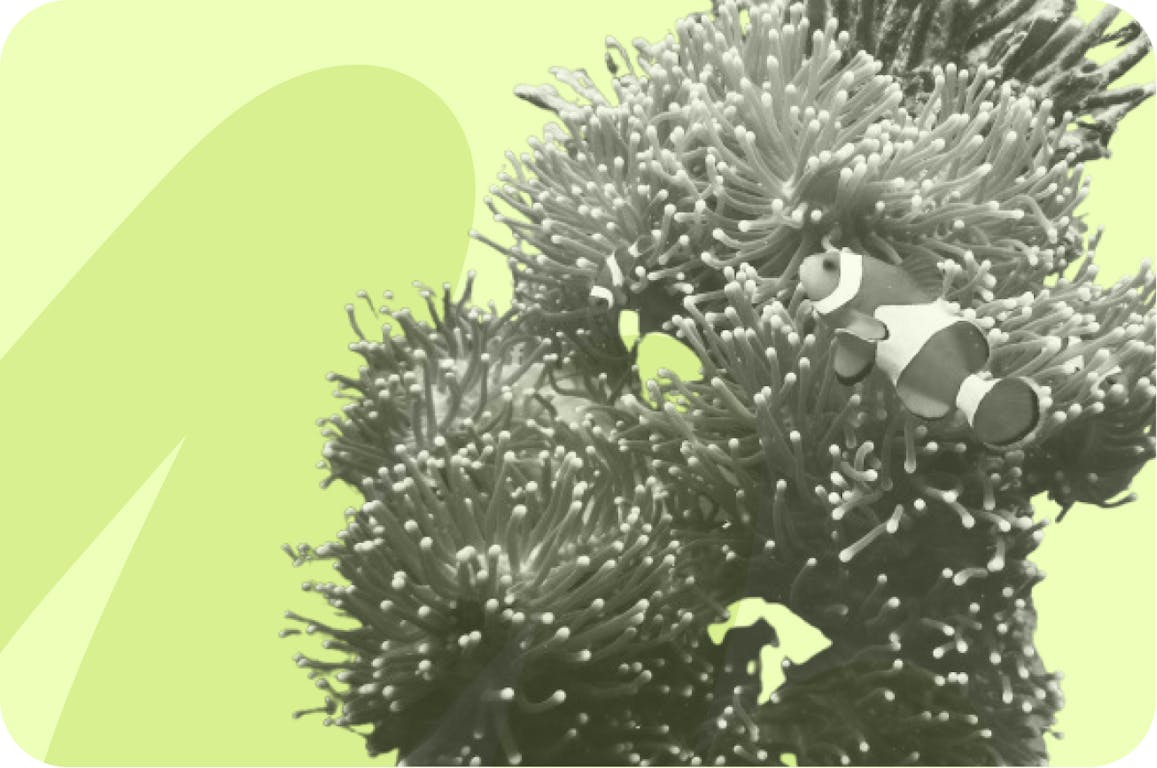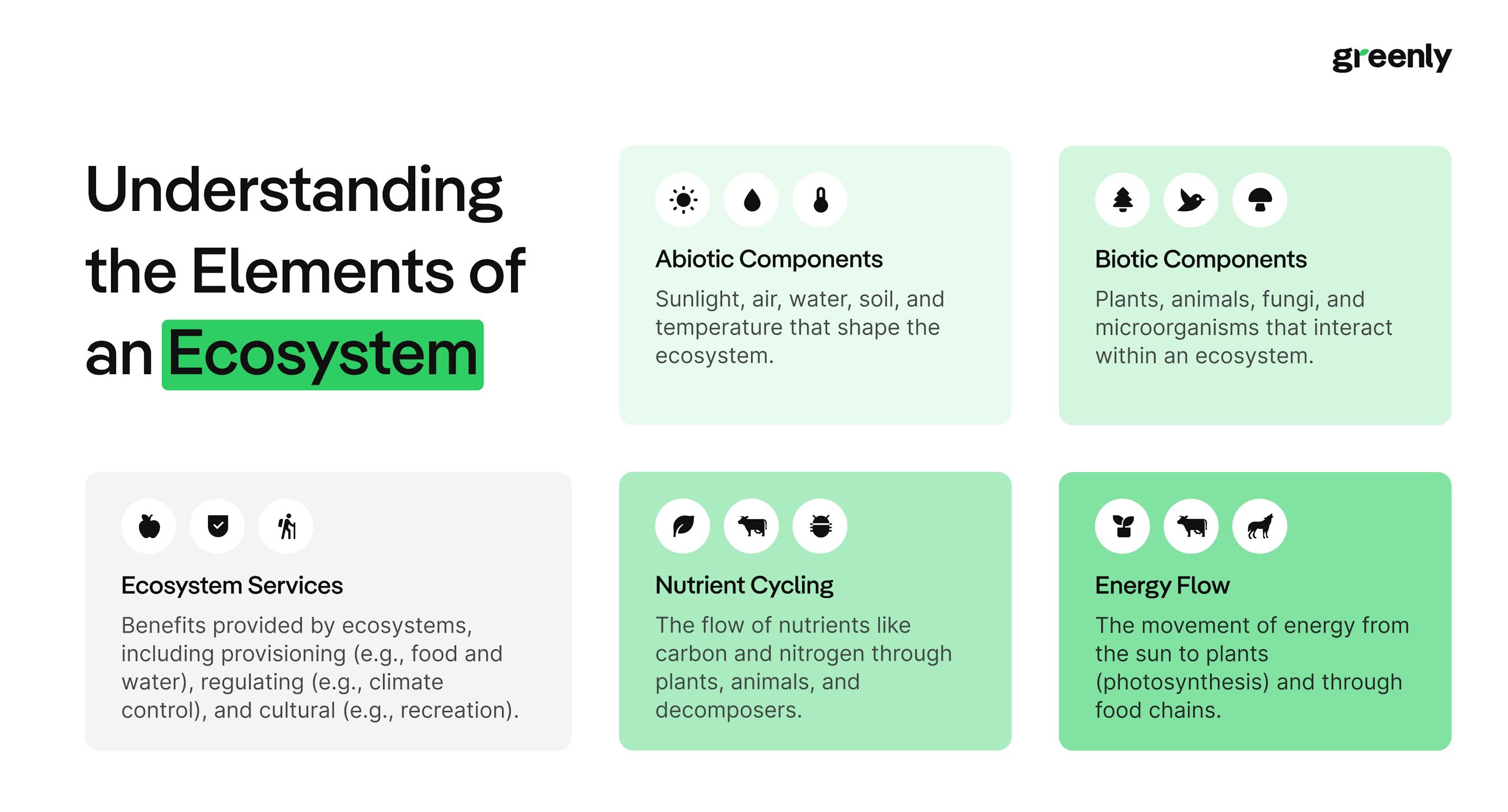
Sustainable Development Goals (SDGs): All You Need to Know
The United Nations has defined 17 goals, aimed at creating a better world. What are these so-called "Sustainable Development Goals" ? Explanations.
ESG / CSR
Industries



These natural networks do much more than support biodiversity - they’re also essential to regulating our climate. Forests, oceans, and grasslands all play crucial roles, from storing carbon to influencing weather, and their health is now directly under threat from climate change.
In this article, we’ll break down what an ecosystem is, how these systems are built, and why they matter more than ever in the face of our changing climate.
To understand what an ecosystem truly is, let’s start by breaking down the word into its components: “eco” and “system.”
“Eco” is rooted in ecology - ie. the study of how living organisms (plants, animals, and microorganisms) interact with each other and with non-living elements like soil, air, and water. When combined with “system”, it describes an organized network of these interactions, where every part - whether living or non-living - is intricately connected.
However, understanding the different components and interactions within an ecosystem is only the start - these networks are also heavily influenced by external factors that can tip the balance.
Ecosystems are made up of two primary components: biotic and abiotic elements, which together create a self-sustaining environment that supports entire communities of organisms.
Together, biotic and abiotic components interact through ecosystem processes - such as nutrient cycling and energy flow - that sustain ecosystem stability and resilience. For example, plants (biotic) use sunlight and soil nutrients (abiotic) to grow, providing food and energy for other organisms.
These interactions form the foundation of ecosystem structure, supporting the balance that allows ecosystems to function and thrive.


As we've already touched on, ecosystems rely on the continuous flow of energy and nutrients - a cycle that sustains all forms of life.
At the heart of this system are three essential roles that species play: producers, consumers, and decomposers. These roles help drive vital cycles, such as the carbon, water, and nitrogen cycles, that make Earth habitable and keep ecosystems functioning.
Producers, like trees, grasses, and algae, are the foundation of all ecosystems.
Through photosynthesis, they harness energy from sunlight and absorb carbon dioxide, water, and nutrients from their environment to create new growth (essentially they make their own food).
These organisms don’t just sustain themselves - they produce the organic matter that serves as the starting point for the entire food web. Producers enable life to thrive by converting abiotic components into energy-rich biomass that consumers rely on.
Consumers are organisms that cannot produce their own energy and must instead consume other organisms - whether plants, animals, or both - to survive.
Herbivores, carnivores, and omnivores all fall into this category. For example, a rabbit grazing on grass acts as a primary consumer, while a wolf preying on these primary consumers is considered a secondary consumer.
Consumers help regulate populations within ecosystems and keep the balance between species.
Decomposers, such as fungi, bacteria, and certain insects, play a critical role in breaking down dead material from producers and consumers. They transform organic waste into simpler substances, enriching the soil with nutrients that plants need to grow.
Without decomposers, ecosystems would accumulate dead material, and the soil would eventually be depleted of nutrients. By returning essential nutrients to the environment, decomposers ensure that ecosystems remain healthy and self-sustaining.
Ecosystems around the world vary widely, shaped by differences in climate, geography, and available resources.
These ecosystems can be grouped into larger biomes - expansive regions that share similar climate patterns, vegetation, and wildlife. Biomes, such as forests, grasslands, deserts, and aquatic areas, serve as categories that encompass multiple, diverse ecosystems.
Terrestrial ecosystems exist on land and include various types, each adapted to unique climates and landscapes:
Aquatic ecosystems cover the majority of Earth’s surface and can be divided into freshwater and the marine ecosystem:
Among the various ecosystems, tropical rainforests are especially crucial due to their unparalleled biodiversity.
These ecosystems remain warm and humid year-round, providing stable conditions that support numerous species. Rainforests produce oxygen, store carbon, and offer a unique layered structure - such as canopies and understories - each supporting specialized species.
This structure makes rainforests some of the most resilient and complex ecosystems on Earth.
Named for the central stone in an arch that holds all other stones in place, keystone species have a stabilizing effect on ecosystems, often influencing the diversity and structure of their communities.
When a keystone species is removed, ecosystems can experience dramatic changes, often leading to a decline in biodiversity and ecosystem stability.
One well-known example is the wolf in Yellowstone National Park. When wolves were reintroduced to Yellowstone, they helped control the population of elk, their primary prey. With fewer elk grazing on young trees, plant life rebounded, leading to increased biodiversity in the area. This example illustrates how predators can indirectly benefit other species, from vegetation to birds and even small mammals.
Another example is the sea otter in kelp forest ecosystems along the Pacific Coast. Sea otters prey on sea urchins, which feed on kelp. When otter populations decline, sea urchin numbers grow unchecked, leading to overgrazing on kelp and the collapse of the forest ecosystem. By keeping urchin populations in check, sea otters help protect the kelp forests that provide shelter and food for many marine species.
Keystone species highlight the interconnectedness of ecosystems, demonstrating that even a single species can significantly impact biodiversity and ecosystem function.
Their presence supports ecological stability by maintaining food webs, nutrient cycles, and habitat structures.
While ecosystems and biodiversity are closely related, they refer to different aspects of the natural world.
An ecosystem is a community of living organisms interacting with each other and their physical environment, including all the biotic (living) and abiotic (non-living) components that support life in a given area.
In contrast, biodiversity refers specifically to the variety of life within that ecosystem, encompassing the range of species, genetic diversity, and the complex interactions that occur among them. Biodiversity is what makes ecosystems dynamic and resilient, providing a rich array of organisms that fill unique roles and create balanced, self-sustaining systems.
Ecosystems are essential to both human life and the planet’s overall health, providing what are known as ecosystem services - the benefits that natural systems deliver to humanity and other living beings.
These services support everything from agriculture and clean water to climate regulation and cultural enrichment.
Understanding and preserving these services is crucial to maintaining the balance of life on Earth.
Ecosystem services are generally categorised into four main types:
| Type of Service | Description |
|---|---|
| Provisioning services | Direct natural resources ecosystems provide, such as food, water, timber, and medicinal plants. Forests supply wood and natural medicines, while freshwater sources provide drinking water and fish. These resources form the foundation of human economies and are essential for our survival. |
| Regulating services | Help maintain environmental stability. Forests and wetlands act as carbon sinks, absorbing CO2 and mitigating climate change, while wetlands filter pollutants to improve water quality. Coastal ecosystems like mangroves and coral reefs buffer shorelines from storms and prevent erosion, protecting both people and property. |
| Supporting services | Underlying processes that sustain ecosystems and allow other services to exist, such as nutrient cycling, soil formation, and photosynthesis. Decomposers break down organic matter, enriching the soil and supporting plant growth, which sustains food chains. |
| Cultural services | Offer cultural and recreational value. Activities like hiking, birdwatching, and visiting national parks provide peace, inspiration, and connection to nature. These services contribute to mental well-being, cultural practices, and tourism economies. |
Ecosystems are not just resources for human use - they are intricate, self-sustaining networks that maintain the stability of life on Earth.
By supporting biodiversity, they create habitats for countless species and regulate natural systems, such as water cycles and our climate. Ecosystems also build resilience, enabling natural systems to adapt and recover from changes or disruptions.
Human activity has altered ecosystems on a global scale, threatening biodiversity, reducing ecosystem resilience, and disrupting the natural processes that sustain life.
These impacts come from both direct actions - like deforestation, urban expansion, and pollution - and from broader changes driven by climate change.
Human activity and climate change together place immense pressure on ecosystems, destabilizing the natural systems that support life. Protecting ecosystems from further harm requires urgent action to limit pollution, reduce deforestation, and mitigate climate change.
As ecosystems face increasing pressures from human activity and climate change, the path forward depends on our commitment to restoration, conservation, and proactive efforts to protect these vital systems.
Without meaningful intervention, ecosystems will continue to lose resilience, reducing their ability to support biodiversity, regulate climate, and provide essential resources.
Restoring and conserving ecosystems is critical for reversing damage and ensuring a stable future. Key initiatives include:
In addition to on-the-ground restoration, emerging technologies, and protective policies are also helping to protect ecosystems:
The future of ecosystems relies on our collective efforts to protect and restore them. Governments, organizations, communities, and individuals all play a role in fostering sustainable practices and reducing harmful impacts on the environment.